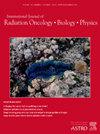低分割立体定向放疗不同剂量分割方案联合贝伐单抗治疗复发性高级别胶质瘤的疗效:一项随机对照试验
IF 6.5
1区 医学
Q1 ONCOLOGY
International Journal of Radiation Oncology Biology Physics
Pub Date : 2025-10-14
DOI:10.1016/j.ijrobp.2025.08.031
引用次数: 0
摘要
目的/目的:低分割立体定向放疗(HSRT)联合贝伐单抗是复发性高级别胶质瘤(HGG)的一种有希望的治疗策略。然而,HSRT的最佳剂量分割模式尚不明确。这项随机2期试验旨在比较不同剂量分离方案(27 Gy/3、30 Gy/5和35 Gy/10)的HSRT联合贝伐单抗治疗复发性HGG的疗效和毒性。材料/方法HGG复发患者(WHO分级3-4级),从先前放化疗完成到复发间隔≥6个月。共有102名患者入组并接受HSRT联合贝伐单抗治疗。这些患者按1:1:1的比例随机分配到三个HSRT组:a组(3次27 Gy, 9 Gy/次),B组(5次30 Gy, 6 Gy/次)和C组(10次35 Gy, 3.5 Gy/次),每组34例患者。所有患者在第1天开始使用贝伐单抗,同时进行HSRT,并每14天继续治疗,直到疾病进展。主要终点是客观缓解率(ORR),次要终点包括6个月无进展生存期(PFS)、总生存期(OS)和治疗相关毒性。结果A组和B组的orr均显著高于C组(分别为79.4%、73.5%和50.0%,p = 0.023)。与C组相比,A组和B组的6个月PFS率也明显更高(分别为67.6%,61.8%和47.1%;p = 0.023)。OS组间差异无统计学意义(分别为85.3%、79.4%和76.5%;p = 0.81)。多因素分析发现,HSRT剂量分级(27 Gy/3F或30 Gy/5F vs 35 Gy/10F)、肿瘤分级(3级vs 4级)、IDH状态(突变型vs野生型)、1p/19q状态(编码缺失vs非编码缺失)是PFS的重要预测因素。严重(≥3级)治疗相关毒性在组间无显著差异。但与C组相比,A组和B组1-2级头痛、恶心/呕吐、失眠、脱发、食欲不振、疲劳发生率较高,A组和B组之间无显著差异。结论分割立体定向放疗联合贝伐单抗并发治疗复发性高级别胶质瘤与较低单次剂量方案(35 Gy/10)相比,较高单次剂量(27 Gy/3和30 Gy/5)的HSRT方案显示出改善的ORR和PFS。尽管严重的不良事件具有可比性,但这些较高的单组分剂量方案与增加的1-2级毒性相关。本文章由计算机程序翻译,如有差异,请以英文原文为准。
Efficacy of Hypofractionated Stereotactic Radiotherapy with Different Dose Fractionation Regimens Combined with Concurrent Bevacizumab in Recurrent High-Grade Gliomas: A Randomized Controlled Trial
Purpose/Objective(s)
Hypofractionated stereotactic radiotherapy (HSRT) combined with concurrent bevacizumab represents a promising treatment strategy for recurrent high-grade gliomas (HGG). However, the optimal dose fractionation pattern of HSRT remains undefined. This randomized phase 2 trial aimed to compare the efficacy and toxicity profiles of HSRT delivered in different dose fractionation schedules (27 Gy/3 fractions, 30 Gy/5 fractions, and 35 Gy/10 fractions) in combination with concurrent bevacizumab for treating recurrent HGG.
Materials/Methods
Eligible patients were those with recurrent HGG (WHO grade 3-4) and an interval of ≥6 months from completion of prior chemoradiation to recurrence. A total of 102 patients were enrolled and received HSRT combined with concurrent bevacizumab. These patients were randomly assigned in a 1:1:1 ratio to three HSRT groups: group A (27 Gy in 3 fractions, 9 Gy/fraction), group B (30 Gy in 5 fractions, 6 Gy/fraction), and group C (35 Gy in 10 fractions, 3.5 Gy/fraction), with 34 patients per group. All patients initiated bevacizumab administration on day 1, concurrent with HSRT, and continued treatment every 14 days until disease progression. The primary end point was objective response rate (ORR), with secondary end points including the 6-month progression-free survival (PFS), overall survival (OS) and treatment-related toxicities.
Results
Both group A and group B demonstrated significantly higher ORRs than group C (79.4%, 73.5%, and 50.0%, respectively; p = 0.023). The six-month PFS rates were also notably higher in group A and group B when compared to group C (67.6%, 61.8%, and 47.1%, respectively; p = 0.023). No significant intergroup differences were observed in OS (85.3%, 79.4%, and 76.5%, respectively; p = 0.81). Multivariate analysis identified HSRT dose fractionation (27 Gy/3F or 30 Gy/5F vs 35 Gy/10F), tumor grade (grade 3 vs 4), IDH status (mutation vs wild-type), 1p/19q status (codeletion vs non-codeletion) as significant predictors of PFS. There were no significant intergroup differences in severe (≥ grade 3) treatment-related toxicities. However, group A and group B showed higher incidences of grade 1–2 headache, nausea/vomiting, insomnia, alopecia, loss of appetite, and fatigue compared to group C, with no significant differences observed between group A and group B.
Conclusion
In the treatment of recurrent high-grade gliomas with fractionated stereotactic radiotherapy combined with concurrent bevacizumab, HSRT regimens with higher single-fraction doses (27 Gy/3 fractions and 30 Gy/5 fractions) demonstrated improved ORR and PFS compared to the lower single-fraction dose regimen (35 Gy/10 fractions). Although severe adverse events were comparable, these higher single-fraction dose regimens were associated with increased grade 1–2 toxicities.
求助全文
通过发布文献求助,成功后即可免费获取论文全文。
去求助
来源期刊
CiteScore
11.00
自引率
7.10%
发文量
2538
审稿时长
6.6 weeks
期刊介绍:
International Journal of Radiation Oncology • Biology • Physics (IJROBP), known in the field as the Red Journal, publishes original laboratory and clinical investigations related to radiation oncology, radiation biology, medical physics, and both education and health policy as it relates to the field.
This journal has a particular interest in original contributions of the following types: prospective clinical trials, outcomes research, and large database interrogation. In addition, it seeks reports of high-impact innovations in single or combined modality treatment, tumor sensitization, normal tissue protection (including both precision avoidance and pharmacologic means), brachytherapy, particle irradiation, and cancer imaging. Technical advances related to dosimetry and conformal radiation treatment planning are of interest, as are basic science studies investigating tumor physiology and the molecular biology underlying cancer and normal tissue radiation response.

 求助内容:
求助内容: 应助结果提醒方式:
应助结果提醒方式:


